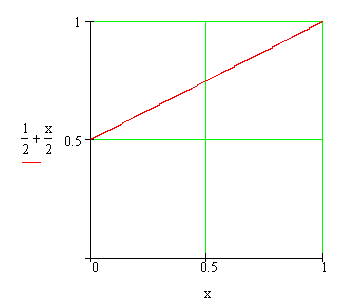
Resources
Math 3 Course Home Page
Math 3 Course Syllabus
Practice Exams
Textbook Home Page
Post a Comment
Contents
In this lecture we state and prove the Fundamental Theorem of Calculus. This theorem has that name because it relates derivatives and integrals, the two main branches of calculus. We also discuss some resulting techniques for evaluating definite integrals.
Quick Question
What is the area under the graph of f(x) = 1/2 + x/2 and above the interval [0,1]? Now let F(x) = x/2 + x2/4; what is F(1) − F(0)?
Outline
Outlines forThe Fundamental Theorem of Calculus
Techniques of Integration
Textbook
The Fundamental Theorem of CalculusTechniques of Integration
Today's Homework
Log into WebWorKQuiz
The Fundamental Theorem of Calculus QuizTechniques of Integration Quiz
Examples
 The Scholastic Aptitude Test (SAT) is rescaled so that the scores of n people, ranging from 0 to 1600, fit a distribution in the shape of the following function: f(x) = sin(πx/1600) (nπ/3200). What is the probability that a random person will score between 1200 and 1250?
The Scholastic Aptitude Test (SAT) is rescaled so that the scores of n people, ranging from 0 to 1600, fit a distribution in the shape of the following function: f(x) = sin(πx/1600) (nπ/3200). What is the probability that a random person will score between 1200 and 1250?
 Find the derivative of a product of a function and an integral.
Find the derivative of a product of a function and an integral.
 Find the derivative of a product of a function and an integral.
Find the derivative of a product of a function and an integral.
 Find the integral from 0 to π/4 of tan(x).
Find the integral from 0 to π/4 of tan(x).
 Use integration by parts to find an expression for the integral from 0 to π/4 of sin(x)5.
taking u = (sin(x))4 and dv = sin(x) dx.
Use integration by parts to find an expression for the integral from 0 to π/4 of sin(x)5.
taking u = (sin(x))4 and dv = sin(x) dx.
 Find
the integral of x2ex.
Find
the integral of x2ex.
Videos
 Use the fundamental theorem of calculus for definite integrals (1)
Use the fundamental theorem of calculus for definite integrals (1)
 Use the fundamental theorem of calculus for definite integrals (2)
Use the fundamental theorem of calculus for definite integrals (2)
 Find the area under y = x4 between x = 1 and x = 5
Find the area under y = x4 between x = 1 and x = 5
 Find the integral from –1 to 1 of x3
Find the integral from –1 to 1 of x3
 Doing the chain rule, backwards
Doing the chain rule, backwards
 Integrate ex/(1 + e2x)
Integrate ex/(1 + e2x)
 Integrate (sin(x))4 ·(cos(x))3
Integrate (sin(x))4 ·(cos(x))3
 Integrate (x + 2)/√(x2 + 4x + π)
Integrate (x + 2)/√(x2 + 4x + π)
 Integrate x27 + 3sin(x)
Integrate x27 + 3sin(x)
 Integrate Ax2 + Bx + C
Integrate Ax2 + Bx + C
